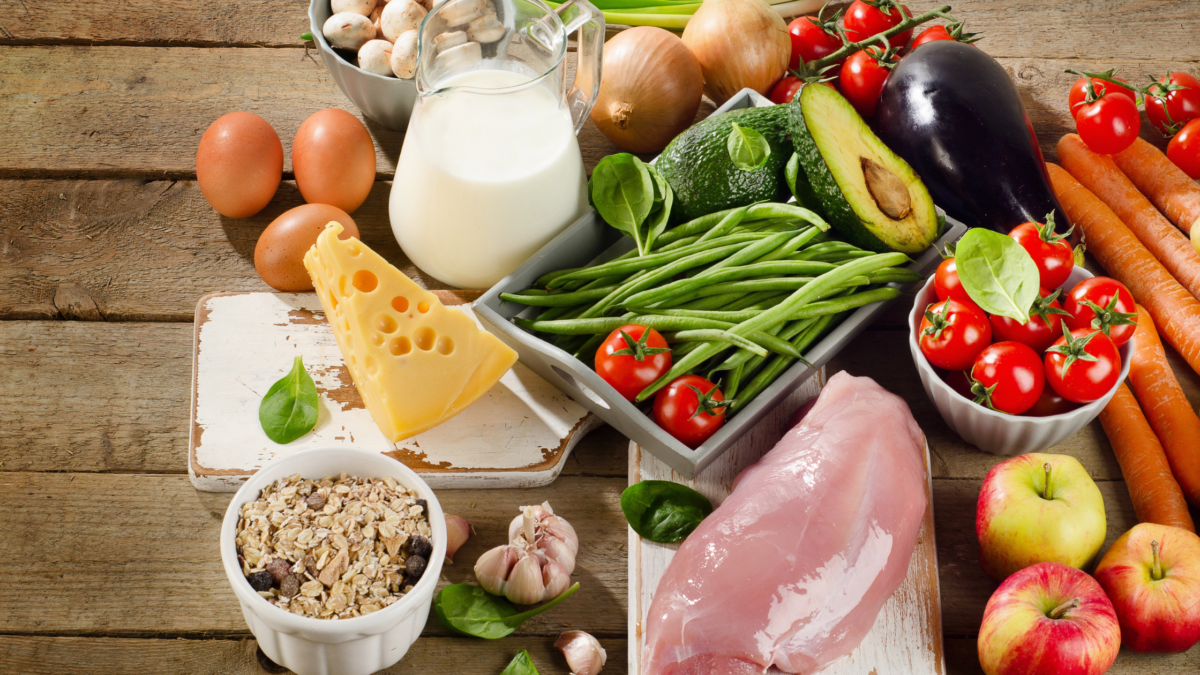


Medically Reviewed By Margaret Etudo. Written By The Vitamins For Woman Team.
The Galveston Diet is more than a weight loss program. It is a detailed lifestyle guide tailored to the needs of women as they navigate the physical and emotional changes associated with menopause. Read on to learn about the Galveston diet meal plan.


medically reviewed by margaret etudo, BPharm. written by the vitamins for woman team.
The Galveston Diet is a comprehensive, evidence-based weight loss and wellness program created for midlife women, particularly perimenopausal and postmenopausal women. Dr. Mary Claire Haver, an OB-GYN, created this diet to address the unique changes women experience during menopause.
Dr. Haver used to advise her patients going through menopause to eat less and exercise more when they had concerns about weight gain. However, when she began experiencing perimenopausal symptoms herself, she noticed that the traditional approach to weight loss did not work for menopausal women. Hormonal changes, lower energy levels, and a slower metabolism made it harder for them to lose weight.
Realizing this, Dr. Haver created the Galveston Diet to address these challenges and help women achieve optimal health and maintain a healthy weight. Unlike quick-fix diets, the Galveston Diet meal plan offers a sustainable, long-term solution for weight management.
The Galveston diet specifically targets women in midlife, particularly those experiencing menopause, to address weight gain and hormonal imbalances that often arise during this stage of life. The diet focuses on three fundamental mechanisms to promote weight loss and improve overall health:
The Galveston diet revolves around three primary components:
Intermittent fasting plays a central role in the Galveston diet. It alternates between eating and fasting periods, with the most common method being the 16:8 schedule, where you fast for 16 hours and eat during an 8-hour window. This helps regulate insulin levels, which can spike during menopause and lead to fat storage, especially around the midsection.
During fasting, the body switches to burning fat for energy, which aids in weight loss and maintaining lean muscle mass. By giving the body a break from constant digestion, intermittent fasting encourages cellular repair and detoxification, improving overall health and longevity.
Anti-inflammatory nutrition addresses the chronic inflammation that often occurs during menopause. Inflammation, a natural response to injury or infection, can become problematic when it is chronic, leading to weight gain, fatigue, cardiovascular diseases, and obesity.
The Galveston diet promotes consuming foods that fight inflammation and reduce its harmful effects on the body. This involves incorporating nutrient-rich whole foods with high levels of antioxidants, healthy fats, and essential nutrients.
The Galveston diet focuses on boosting energy and enhancing fat burning by prioritising the right foods and adjusting your macronutrient balance.
Fuel refocus involves balancing the three main macronutrients—fats, proteins, and carbohydrates—to promote fat-burning and sustained energy. Shifting to fats and proteins for energy prevents the sharp rises and falls in blood sugar from a carb-heavy diet, leading to more sustained energy throughout the day and reducing cravings.
The Galveston diet encourages whole, nutrient-dense, anti-inflammatory foods to support hormone balance, weight loss, and overall health. There are lots of tasty foods you can eat on a Galveston diet, including the following:
Olive oil, coconut oil, avocado oil, ghee.
Spinach, kale, lettuce, mustard greens, turnip greens.
Chia, sesame, flax, pumpkin, sunflower seeds.
Eggs, tuna, chickpeas, turkey, codfish, chicken.
Walnuts, almonds, cashews, pistachios, pecans, hazelnuts.
Almond milk, cottage cheese, coconut milk, Greek yoghurt.
Green, black, peppermint, chamomile, ginger teas.
Basil, turmeric, parsley, thyme, oregano.
Apple, avocado, blueberries, orange, strawberries, grapes.
The Galveston diet emphasizes avoiding foods that lack nutrients and contribute to inflammation and weight gain, especially during menopause. You should stay away from:
Artificial sweeteners such as aspartame and saccharin.
Artificial colourings, preservatives, emulsifiers.
Wine, beer, spirits, cocktails.
Hotdogs, canned foods, soda, chips, sausages, instant noodles, fried foods.
Margarine, soybean oil, corn oil, safflower oil.
The Galveston diet aids weight loss by targeting women’s challenges during menopause, such as hormonal changes, inflammation, and slower metabolism. The diet focuses on anti-inflammatory foods, reducing refined carbohydrates, and encouraging intermittent fasting to prevent fat accumulation and balance hormones.
While the Galveston diet has yet to undergo specific research, its core components, intermittent fasting and low-carb dieting, are well-supported by numerous studies for their effectiveness in promoting weight loss.
Research shows that low-carb diets tend to produce faster weight loss than other methods, especially within the first 6 to 12 months.
In five trials involving 447 participants, those on low-carb diets lost more weight after 6 months than those following low-fat diets.
A review of 40 publications showed that intermittent fasting aids weight loss, with people typically losing 7–11 pounds over 10 weeks.
The Galveston diet offers numerous benefits, including weight loss.
Combining intermittent fasting and low-carb meals helps promote fat burning and reduce excess weight. Protein-rich foods and healthy fats help promote satiety and satisfaction.
By cutting out processed foods and focusing on nutrient-rich options, the Galveston diet helps stabilise blood sugar levels, preventing energy crashes.
The Galveston diet emphasises anti-inflammatory foods like leafy greens, healthy fats, and lean proteins. This helps lower chronic inflammation, linked to various health problems, including weight gain, heart disease, and joint pain.
Unlike many restrictive diets, the Galveston diet focuses on long-term health rather than quick fixes. It encourages a balanced approach to eating that is sustainable and easy to maintain, making it suitable for lasting weight management.
Though the Galveston diet has many benefits, there are also some potential downsides.
While the Galveston diet includes well-researched elements like intermittent fasting and a low-carb approach, it lacks rigorous clinical trials to support its long-term effectiveness and overall health impact for a broader audience.
Reducing refined carbohydrates and sugars can feel restrictive, especially for those used to eating a more balanced variety of foods, including grains and fruits. This could make it difficult for some people to adhere to the diet over the long term.
Intermittent fasting can be difficult for some, particularly those with certain medical conditions like diabetes, eating disorders, or people who are pregnant or breastfeeding. It may also lead to fatigue, irritability, or difficulty concentrating for some people.
The Galveston diet generally follows a 16:8 intermittent fasting schedule, where you fast for 16 hours and eat all meals within an 8-hour period. However, the intermittent fasting approach is flexible, and you can adjust the fasting schedule to fit individual preferences and needs.
Yes, you can eat eggs on the Galveston diet. Eggs are a great source of protein and healthy fats, making them an ideal food that aligns with the diet’s focus on anti-inflammatory nutrition and low-carb, nutrient-dense meals. They’re also versatile; you can include them in various meals throughout the day.
Egg-based Galveston diet recipes include scrambled eggs with spinach and avocado, omelette with mushrooms and bell peppers, and vegetable frittata.
To start the Galveston diet, first familiarise yourself with its core components, which include intermittent fasting, focusing on anti-inflammatory foods, and reducing carbs.
Begin with a 16:8 fasting schedule, where you fast for 16 hours and eat during an 8-hour window. Make your meals rich in healthy fats like avocados, olive oil, and nuts, along with lean proteins such as chicken, fish, and eggs. Avoid refined carbs, sugary foods, and processed snacks, opting instead for fibre-rich vegetables and whole foods.
Stay hydrated throughout the day, especially during fasting periods, and plan your meals in advance to make it easier to follow the diet consistently. Transition into it slowly and adjust based on how your body responds.
To start the Galveston diet, first familiarise yourself with its core components, which include intermittent fasting, focusing on anti-inflammatory foods, and reducing carbs.
Begin with a 16:8 fasting schedule, where you fast for 16 hours and eat during an 8-hour window. Make your meals rich in healthy fats like avocados, olive oil, and nuts, along with lean proteins such as chicken, fish, and eggs. Avoid refined carbs, sugary foods, and processed snacks, opting instead for fibre-rich vegetables and whole foods.
Stay hydrated throughout the day, especially during fasting periods, and plan your meals in advance to make it easier to follow the diet consistently. Transition into it slowly and adjust based on how your body responds.
[…] Read: Galveston Diet Meal Plan: A Solution to Menopause Weight Gain […]
Your point of view caught my eye and was very interesting. Thanks. I have a question for you.
Your point of view caught my eye and was very interesting. Thanks. I have a question for you.
Thank you, your article surprised me, there is such an excellent point of view. Thank you for sharing, I learned a lot.
Thank you for your sharing. I am worried that I lack creative ideas. It is your article that makes me full of hope. Thank you. But, I have a question, can you help me?
Thank you for your sharing. I am worried that I lack creative ideas. It is your article that makes me full of hope. Thank you. But, I have a question, can you help me?